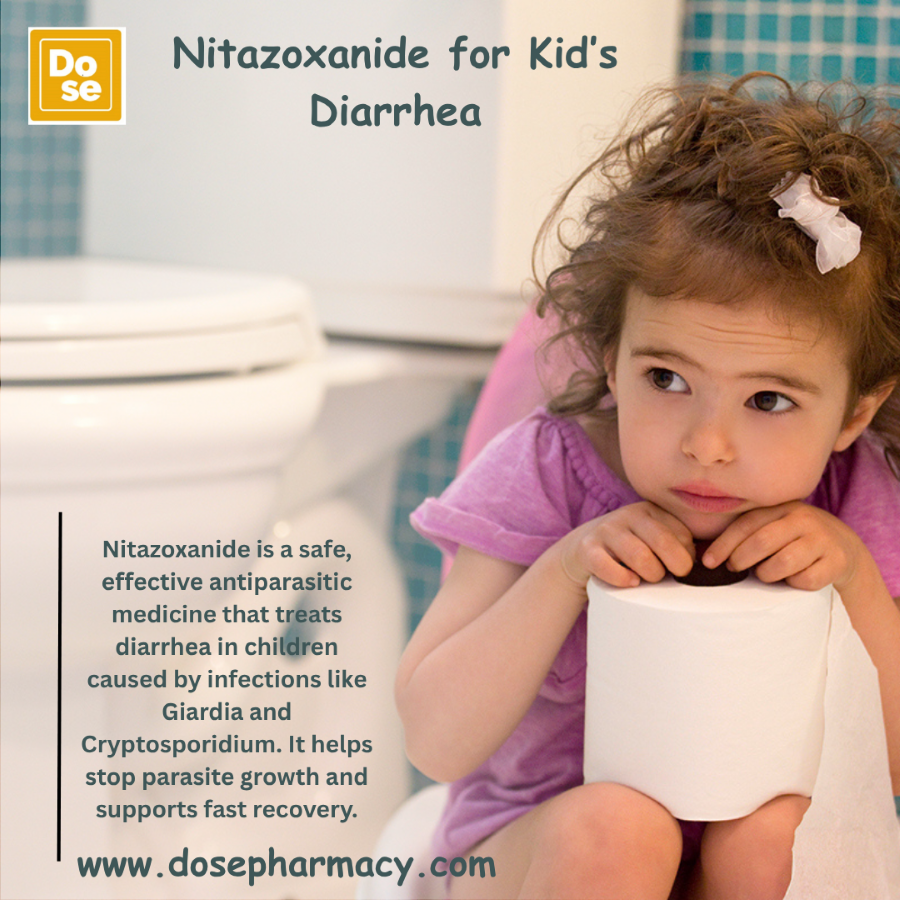When it comes to treating intestinal infections caused by parasites, Nitazoxanide 500 mg has become one of the most widely prescribed medications worldwide. Known for its effectiveness against protozoa such as Giardia lamblia and Cryptosporidium parvum, Nitazoxanide is often used to relieve symptoms like diarrhea, abdominal cramps, and nausea. But one of the most important aspects of prescribing this drug lies in age-appropriate dosing. Children are not just “small adults,” and their bodies process medicines differently. This makes dosage adjustment critical to ensure safety and effectiveness.
In this article, we will explore how the dosage of Nitazoxanide differs for children compared to adults, why weight and age matter, how the suspension form is used in pediatrics, and what precautions caregivers should know.
What Is Nitazoxanide?
Nitazoxanide is an antiparasitic and broad-spectrum antiviral drug. It works by interfering with the energy production process of parasites, essentially cutting off their ability to survive. It is especially useful in treating infections like:
-
Giardiasis (caused by Giardia lamblia)
-
Cryptosporidiosis (caused by Cryptosporidium parvum)
-
Certain types of chronic diarrhea associated with parasitic infections
It is available in two common formulations:
-
Tablets (usually 500 mg) – recommended for adults and older children.
-
Oral suspension (liquid) – designed for younger children who may have trouble swallowing pills.
Why Is Pediatric Dosage Different?
Children’s bodies metabolize and eliminate drugs differently than adults. Key reasons why their dosage must be adjusted include:
-
Weight-based metabolism: Children have higher metabolic rates, so drugs may be cleared from their system faster.
-
Developing liver and kidneys: These organs are responsible for drug breakdown and elimination, and they may not yet function at full adult capacity.
-
Safety concerns: Too high a dose could increase the risk of side effects like abdominal pain, vomiting, or headache.
Therefore, Nitazoxanide dosage is carefully divided based on age group and sometimes body weight. You can also visit dosepharmacy to get more information about Nitazoxanide.
Dosage of Nitazoxanide for Adults vs. Children
Adult Dosage
-
Standard dose: 500 mg tablet
-
Frequency: Twice daily (every 12 hours)
-
Duration: 3 days
Children’s Dosage
The dosing for children is age-specific:
-
Children 1–3 years old:
-
Dose: 100 mg (5 mL of oral suspension)
-
Frequency: Twice daily
-
Duration: 3 days
-
-
Children 4–11 years old:
-
Dose: 200 mg (10 mL of oral suspension)
-
Frequency: Twice daily
-
Duration: 3 days
-
-
Children 12 years and older:
-
Usually given the adult dose (500 mg tablet twice daily for 3 days).
-
💡 The suspension form is commonly prescribed for children under 12, while tablets are reserved for older children who can swallow pills.
Importance of the Suspension Form
The oral suspension is particularly important for pediatric patients. Each 5 mL (teaspoon) contains 100 mg of Nitazoxanide, allowing precise measurement for small children. Caregivers should use the measuring spoon or cup provided with the medicine instead of household spoons, which can lead to incorrect dosing.
Factors That Influence Pediatric Dosage
While standard recommendations are widely followed, doctors sometimes adjust doses based on:
-
Weight of the child – Heavier children may require a slightly higher volume of suspension.
-
Severity of infection – More severe diarrhea may require careful monitoring to ensure the drug is working.
-
Underlying conditions – Children with liver or kidney problems may need a modified dose.
-
Tolerance and side effects – If side effects occur, the doctor may adjust the dose or switch therapy.
Example: Comparison of Dosing in a 3-Year-Old vs. 10-Year-Old
-
A 3-year-old child (approx. 12–14 kg) → 100 mg (5 mL suspension) twice daily.
-
A 10-year-old child (approx. 30 kg) → 200 mg (10 mL suspension) twice daily.
-
An adult or a 14-year-old teenager → 500 mg tablet twice daily.
This comparison clearly shows how dosage scales up with age and weight.
Safety and Side Effects in Children
Nitazoxanide is generally well-tolerated in children, but some side effects may occur:
-
Common side effects: Stomach pain, nausea, headache, diarrhea, or vomiting.
-
Less common but possible: Yellowish discoloration of eyes or urine (harmless and temporary).
-
Serious but rare: Allergic reactions like rash, itching, or breathing difficulty.
Parents should seek medical attention if severe reactions occur.
Precautions for Parents and Caregivers
-
Always give the medicine with food – This improves absorption and reduces stomach upset.
-
Do not skip doses – Missing doses can make the treatment less effective.
-
Complete the full course – Even if symptoms improve, the full 3-day treatment is necessary.
-
Check for drug interactions – Inform the doctor about other medications the child is taking.
-
Storage – Suspension should be stored as per instructions and shaken well before use.
Why Following the Correct Dose Matters
Giving too little Nitazoxanide may not clear the infection completely, leading to persistent diarrhea or reinfection. On the other hand, giving too much increases the risk of side effects. This is why age-specific pediatric dosing guidelines must always be followed.
Nitazoxanide is an effective treatment for parasitic infections like giardiasis and cryptosporidiosis in both adults and children. However, its dosage for children is significantly different and carefully adjusted by age and weight. While adults typically receive 500 mg twice daily for 3 days, children are prescribed 100 mg (1–3 years) or 200 mg (4–11 years) in suspension form.
For safe use, parents should always administer the medicine as directed by a healthcare professional, use the provided measuring device, and complete the full treatment course. With proper dosing, Nitazoxanide can quickly and effectively relieve symptoms, helping children recover from intestinal infections with minimal side effects.

